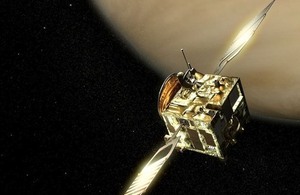Venus Express gets ready to take the plunge
Venus Express completes science observations and prepares to enter the planet’s hostile atmosphere.

Artist's impression of Venus Express. Credit: ESA.
After eight years in orbit, Europe’s Venus Express has completed routine science observations and is preparing for a daring plunge into the planet’s hostile atmosphere.
Venus Express was launched on 9 November 2005, and arrived at Venus on 11 April 2006. With British involvement in five of the mission’s instruments, it has been an important project for the UK.
The satellite has been orbiting Venus in an elliptical 24-hour loop that takes it from a distant 66 000 km over the south pole – affording incredible global views – to an altitude of around 250 km above the surface at the north pole, close to the top of the planet’s atmosphere.
With a suite of seven instruments, the spacecraft has provided a comprehensive study of the ionosphere, atmosphere and surface of Venus. Now, after eight years in orbit, the fuel supplies necessary to maintain the elliptical orbit are running low and will soon be exhausted. Thus, routine science operations concluded last week, and the spacecraft is being prepared for one final mission: to make a controlled plunge deeper into the atmosphere than ever before attempted.
We have performed previous short ‘aerodrag’ campaigns where we’ve skimmed the thin upper layers of the atmosphere at about 165 km, but we want to go deeper, perhaps as deep as 130 km, maybe even lower
says Patrick Martin, Venus Express mission manager.
It is only by carrying out daring operations like these that we can gain new insights, not only about usually inaccessible regions of the planet’s atmosphere, but also how the spacecraft and its components respond to such a hostile environment
This ‘experimental aerobraking’ phase is planned for 18 June – 11 July, during which time some limited science measurements with the spacecraft’s magnetic field, solar wind and atom analysing instruments will be possible. Also, temperature and pressure sensors will record the conditions that the spacecraft is experiencing.
The campaign also provides the opportunity to develop and practise the critical operations techniques required for aerobraking, an experience that will be precious for the preparation of future planetary missions that may require it operationally
says Paolo Ferri, head of mission operations.
Aerobraking can be used as a way of getting into orbit around planets without having to carry quite so much fuel, thus reducing the launch mass. It is possible that the remaining fuel in Venus Express will be exhausted during this phase or that the spacecraft does not survive these risky operations. But if the spacecraft is still healthy afterwards, its orbit will be raised again and limited operations will continue for several more months, fuel permitting.
However, by the end of the year, it is likely that Venus Express will have made its final descent into the atmosphere of the planet, bringing a fantastic scientific endeavour to an end.